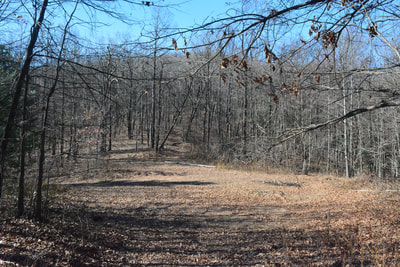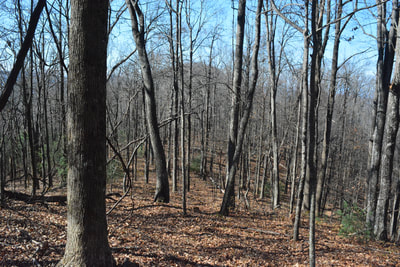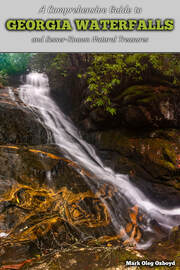
There's something about the Duncan Ridge Trail that sets it apart from most other trails in Georgia: its sheer difficulty. This unique trail constantly follows Duncan Ridge with its sharp knobs and deep gaps that present constant obstacles along the trail. The rollercoaster fashion of the Duncan Ridge Trail will give you a tough workout, and that's exactly why most people hike it - for there are no spectacular waterfalls anywhere on the trail. The trail is best hiked in the winter when bare trees allow continuous views in both directions from the ridge. Even though there is only one year-round view - on Rhodes Mountain - of any significance along the west part of the trail, seasoned hikers will still find it an enjoyable peaceful hike. This hike occurred on Thursday, November 23rd, 2017. My plan was to hike out and back along the Duncan Ridge Trail from Mulky Gap to the Benton Mackaye Trail Junction just past the view from Rhodes Mountain.
Summary
R/T Length of Trail: 13.5 Miles
Duration of Hike: 8:20 plus 30 minutes of break Type of Hike: Out and Back Difficulty Rating: 10 out of 10 Total Elevation Gain: 4685 Feet Pros: Solitude and great winter views Cons: Very difficult trail with constant uphill and downhill scattered all throughout the hike Points of Interest: View from Akin Mountain - 2 stars; View from Rhodes Mountain - 2 stars Trail Blaze Colors: Duncan Ridge Trail - Blue Best Seasons to Hike: Winter Fees: None Beginning Point: Mulky Gap Directions from Blairsville, GA: From the intersection of Highway 76/2 and Blue Ridge Highway near downtown Blairsville, follow Blue Ridge Highway west for 2.9 miles. Then, turn left onto Mulky Gap Road. Follow it as it turns into FS 4 for 5.6 miles to Mulky Gap, where there is a very wide area suitable for parking. The Duncan Ridge Trail crosses the unpaved road at this spot. If you drive all the way to a sign for the Cooper Creek Wildlife Management Area, then you have just missed the Mulky Gap Trailhead. Map
Click the link below to download a .GPX file with a track of this hike.
Details
The best way to describe a hike on the Duncan Ridge Trail from Mulky Gap to Rhodes Mountain is a strenuous aerobic exercise. It's no wonder that the Duncan Ridge Trail is known as one of the the most difficult trails in the state, as there simply isn't any comparable trail that follows such a long narrow ridge and visits nearly every bump and dip along it. From the two sections of the Duncan Ridge Trail, I decided to pick the section to Rhodes Mountain rather than Coosa Bald because it is more secluded with less road access.
From Mulky Gap, pick up the blue-blazed trail as it heads steeply uphill to the west from a carsonite stake at the road. This is the right-hand side of the road if coming from Blairsville. The Duncan Ridge Trail follows the north boundary of the Cooper Creek Wildlife Management Area for nearly all of its length between Mulky Gap and Rhodes Mountain, as the WMA boundary roughly straddles the ridgeline. A moderate 700-foot ascent to Akin Mountain begins. Although this is the highest single ascent on the hike, it is relatively easy compared to some of the other steeper knobs. The trail reaches the ridge at 0.6 miles and nears the summit of Akin Mountain at 0.95 miles, although it does not cross the very top. A series of small rock outcrops near the summit provides a beautiful winter view and partial summer view to the east and south. The Duncan Ridge Trail passes through a gap at 1.3 miles and then reaches Clements Mountain, the second of eight mountains along the hike (in each direction), at 1.6 miles. A long descent begins here, and this part will be particularly annoying on your way back. After descending 500 feet, the Duncan Ridge Trail reaches Akin Gap at 2.3 miles. What follows is one of the easiest sections of the trail as it actually leaves the ridge for once and contours along a nearly level path through mountain laurel thickets on the south side of Fish Knob before emerging to Fish Gap at 2.95 miles. Just before Fish Gap is an ironic sign that states "You Are Not Almost There". It's the truth, because the hike so far has been a relative piece of cake, and coming up past Fish Gap is a particularly hardcore stretch of trail along one of the most rugged parts of the ridge. A dirt road identified as Ridge Runner Trail accesses Fish Gap from Mulky Gap Road, although it may be in fairly rough condition. Cross the turnaround area in Fish Gap and continue following the trail as it begins a slow ascent along an old forest road on the north side of Parke Knob. Even though the trail stays well below the summit, I still consider this to be the third mountain on the hike - especially if the much more difficult climb on the way back is factored in. The first of a series of very steep grades brings the trail to Sarvis Gap at 4.0 miles, where there is a side trail to a water source in the headwaters of Long Cove Creek. The next two mountains are the most difficult ascents on the hike in my opinion. In the next half-mile, the trail ascends 400 feet to Payne Knob, reaching it at 4.5 miles. Then, it drops 250 feet in 0.3 miles to an unnamed gap and climbs 250 feet in 0.25 miles to Gregory Knob at 5.05 miles. There are excellent winter views from the pointed summits of both Payne Knob and Gregory Knob, and in fact, the section of the trail between Parke Knob and Rhodes Mountain Gap is one of the trail's most beautiful segments - especially in winter. A 350-foot descent brings the Duncan Ridge Trail to Gregory Gap at 5.35 miles, after which the trail temporarily becomes somewhat easier. The trail next crosses a small knob and then ascends to the north end of Chinquapin Ridge - a side ridge - which is the sixth mountain at 5.7 miles. The next gap, Rhodes Mountain Gap, is at 6.1 miles, after which the trail ascends 200 feet in 0.2 miles to a knob (the seventh mountain) that stands in the shadow of Rhodes Mountain. The final ascent to Rhodes Mountain is perhaps the steepest on the entire hike as it is 250 feet in only 0.2 miles. Reach the summit of Rhodes Mountain at 6.6 miles. A little-used campsite is located just to the right of the trail. The side trail to the view from Rhodes Mountain begins on the right about 200 feet past the summit. It was marked by a cairn at the time of my hike. However, first follow the Duncan Ridge Trail to the Benton Mackaye Trail junction and stop by the view on the way back. After a short, rocky descent, the Duncan Ridge Trail reaches the signed junction at 6.7 miles. The junction with the Benton Mackaye Trail is the turnaround point for the hike. The stand-alone section of the DRT ends at the junction, after which it bears left and joins the BMT on its way to Highway 60, the Toccoa River Swinging Bridge, and eventually Long Creek Falls. The Benton Mackaye Trail also turns right toward Skeenah Gap. From the junction, begin retracing your steps along the endless rollercoaster route. Make sure to take the 250-foot side trail to the view from Rhodes Mountain. The limited northwest view is from a small rock outcrop and is not special, but it's still a nice bonus to this strenous hike. As much of the view is impeded by trees, it looks considerably better in winter. After taking in the small view, continue the hike back to Mulky Gap, which will become slower and tougher with every new ascent. It will be a huge relief when you finally return to Mulky Gap at 13.5 miles, concluding the hike! Mileage
0.0 - Mulky Gap
0.95 - Akin Mountain 1.6 - Clements Mountain 2.3 - Akin Gap 2.95 - Fish Gap 4.0 - Sarvis Gap 4.5 - Payne Knob 5.05 - Gregory Knob 5.35 - Gregory Gap 6.1 - Rhodes Mountain Gap 6.6 - Rhodes Mountain 6.7 - Benton Mackaye Trail Junction 13.5 - Mulky Gap Variations
Hike out and back to Rhodes Mountain and the BMT from Fish Gap - 7.6 Miles
Bonus Stops
A scenic waterfall known as Sea Creek Falls is located south of the Duncan Ridge. It is accessed by a good trail from Sea Creek Road (FS 264) off Cooper Creek Road (FS 4).
Pictures
3 Comments
Giselle Romero
6/20/2020 11:14:35 pm
Thank you! I’ve been looking for this. Attempting in a few weeks.
Reply
John Koenig
10/3/2020 09:48:08 am
Thank you so much for this write-up! Very helpful info.
Reply
Keith Moses
2/11/2022 03:46:50 pm
Great description, spot on. There have since been several reroutes done on this section which now traverse the side of three of these mountains instead of climbing and descending them. This is still an incredibly tough section but around 2000 feet of gain and loss has been removed. One can still use the old sections if you pay attention. Trail runners still use the old sections of trail keeping it in decent shape.
Reply
Leave a Reply. |
About MeMark Oleg Ozboyd Dear readers: I have invested a tremendous amount of time and effort in this website and the Georgia Waterfalls Database the past five years. All of the work that has gone in keeping these websites updated with my latest trip reports has almost been like a full-time job. This has not allowed me to pick up a paid job to save up money for college, and therefore, I I've had to take out loans. If you find the information on this website interesting, helpful, or time-saving, you can say "thanks" and help me out by clicking the button above and making a contribution. I will be very grateful for any amount of support you give, as all of it will apply toward my college tuition. Thank you!
Coming in 2022-2023?
Other Hiking WebsitesMiles HikedYear 1: 540.0 Miles
Year 2: 552.3 Miles Year 3: 518.4 Miles Year 4: 482.4 Miles Year 5: 259.9 Miles Archives
March 2021
Categories
All
|
||||||




































 RSS Feed
RSS Feed